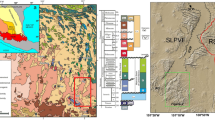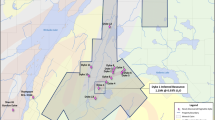Abstract
Detailed geologic surveys and different microscopic and analytical techniques were conducted near Tierra Blanca de Abajo where lung cancer and malignant mesothelioma (MM) are the primary causes of death. Results show that erionite-K occurs as a diagenetic product in altered Oligocene–Miocene rhyolitic tuffs. The microscopic structure of erionite minerals shows concentrations of individual fibers in the range of 0.14–0.547 μm in diameter and 2.81–50 μm in length, with a few “bundles” about 0.2–2.5 μm wide by 10–50 μm long. Chemical properties of erionite show Si/Al in the range of 3.23–3.58 (at.%) and T Si in the range of 0.76–0.78 (at.%). Potassium is the dominant cation (K > Ca > Mg > Fe). Associated minerals are heulandite, clinoptilolite, quartz, sanidine, anorthite, smectite and opal. This mineral assemblage formed in the lower part of an open catchment, where bicarbonate-rich (T > 30 °C, pH > 8) groundwater discharge conditions prevailed in the past. The physical and chemical characteristics of erionite near San Miguel de Allende are similar to those of erionite from the Cappadocian region of Turkey where erionite is associated with MM. The presence of erionite and the type of respiratory diseases that occur in the village strongly suggest the need for detailed health-based studies in the region. Pliocene–Holocene fine-grain deposits, used in the past for the construction of adobe-houses and exposed in recreational areas, also contain erionite associated with erosion and alluvial transport from the rhyolitic tuffs, potentially affecting more than 13 villages located downstream toward the Allende Dam.









Similar content being viewed by others
References
Aguilar-Madrid, G., Robles-Perez, E., Juarez-Perez, C. A., Alvarado-Cabrero, I., Rico-Mendez, F. G., & Kelly-Garcia, J. (2010). Case control study of pleural mesothelioma in workers with social security in Mexico. American Journal of Industrial Medicine, 53, 241–251.
Alanís, R. E. (2002). Evolución geológica de la Cuenca de la Independencia y sus alrededores, estado de Guanajuato. México: Universidad Nacional Autónoma de México, Facultad de Ingeniería, Tesis de Licenciatura, 96 pp.
Artvinli, M., & Baris, Y. I. (1979). Malignant mesotheliomas in a small village in the Anatolian region of Turkey: An epidemiologic study. Journal of National Cancer Institute, 63(1), 17–22.
Baris, Y. I., Sahin, A. A., Ozesmi, M. M., Kerse, I., Ozen, E., Kolacan, B., et al. (1978). An outbreak of pleural mesothelioma and chronic fibrosing pleurisy in the village of Karain/Urgup in Anatolia. Thorax, 33(2), 181–192.
Baris, Y. I., Simonato, L., Artvinli, M., Pooley, F., Saracci, R., Skidmore, J., et al. (1987). Epidemiological and environmental evidence of the health effects of exposure to erionite fibres: A four-year study in the Cappadocian region of Turkey. International Journal of Cancer, 39, 10–17.
Bish, D. L., & Boak, J. M. (2001). Cinoptilolite-heulandite nomenclature. In: D. L. Bish, D. W. Ming (Eds.), Reviews in mineralogy & geochemistry. Natural Zeolites (Vol. 45, pp. 207–216).
Carbone, M., Baris, Y. I., Bertino, P., Brass, B., Comertpay, S., Dogan, A. U., et al. (2011). Erionite exposure in North Dakota and Turkish villages with mesothelioma. Proceedings of the National Academy of Sciences of the United States of America, 108(33), 13618–13623.
De Pablo-Galán, L., & Chávez-García, M. L. (1996). Diagenesis of oligocene vitric tuffs to zeolites, Mexican volcanic belt. Clays and Clay Minerals, 44(3), 324–338.
Dogan, A. U., & Dogan, M. (2008). Re-evaluation and re-classification of erionite-series minerals. Environmental Geochemistry and Health, 30(4), 355–366.
Dogan, A. U., Dogan, M., & Hoskins, J. A. (2008). Erionite-series minerals: Mineralogical and carcinogenic properties. Environmental Geochemistry and Health, 30(4), 367–381.
Ilgren, E. B., et al. (2008). First confirmed erionite related mesothelioma in North America. Indoor and Built Environment, 17, 567–568.
International Agency for Cancer Research (IARC) (2012). Agents classified by the IARC monographs, Vols. 1–105. http://monographs.iarc.fr/ENG/Classification/index.php. Accessed May and December 2012.
International Zeolite Association (IZA) (2013). Index of natural zeolites datasheets. http://www.iza-online.org/. Accessed February 2013.
Jiménez-Cedillo, M.J., Olguín-Gutierrez, M.T., & Solache-Ríos, M.J. (2006). Characterization of Mexican zeolitic rocks. In: R. S. Bowman, S. E. Delap (Eds.), Proceedings of the international conference on the occurrence, properties, and utilization of natural zeolites (pp. 142–143). New Mexico,: Socorro.
Kliment, C. R., Clemens, K., & Oury, T. D. (2009). North American erionite-associated mesothelioma with pleural plaques and pulmonary fibrosis: A case report. International Journal of Clinical and Experimental Pathology, 2, 407–410.
Lowers, H.A., Adams, D.T., Meeker, G.P., Nutt, C.J., (2010). Chemical and morphological comparison of erionite from Oregon, North Dakota, and Turkey. U.S. Geological Survey Open-File Report 2010-1286, p. 13 http://pubs.usgs.gov/of/2010/1286/. Accessed July 2012.
Ortega-Guerrero, M. A. (2009). Presence, distribution, hydrogeochemistry and origin of arsenic, fluoride and other trace elements dissolved in groundwater at a basin scale, tributary of the Lerma-Chapala, Mexico. Revista Mexicana de Ciencias Geológicas, 26(1), 143–161.
Ortega-Guerrero, M. A., & Carrasco-Núñez, G. (2012). Evaluación de los posibles factores de riesgo ambiental en neoplacias pulmonares de la Comunidad de Tierra Blanca de Abajo, San Miguel de Allende, Guanajuato. Reporte Interno del Centro de Geociencias, p. 113.
Ostrumov, F.M. (2006). Zeolitas de México diversidad mineralógica y aplicaciones. Sociedad Mexicana de Mineralogía. http://smm.iim.umich.mx/zeolitas.htm. Accessed January 2013.
Popov, N., Yanev, Y., Iliev, Tz., & Popova, T. (2006). Clinoptilolitized pyroclastic rocks from Oaxaca (south Mexico): A mineralogical and technological study. In: R. S. Bowman, S. E. Delap (Eds), Proceedings of the international conference on the occurrence, properties, and utilization of natural zeolites. Socorro, New Mexico, pp. 208–209.
Servicio Geológico Mexicano (SGM) (1999). Informe de la Carta Geológico-Minera y Geoquímica: Hoja San Miguel de Allende F14C54, Escala 1:50,000, Estado de Guanajuato. [Geology-Ore Deposits and Geochemistry in ID-Chart F14C54 (San Miguel de Allende), Scale 1:50,000, Report of the Council of Mineral Resources] Contrato UNAM-CRM. Secretaría de Comercio y Fomento Industrial. p. 141.
Sheppard, R. A. (1996). Occurrences of erionite in sedimentary rocks of the western United States. Open-File Report 96-018, U.S.. Geological Survey, 26 pp.
Solebello, L., & Tomaino, G. (2011). Differentiation of erionite from other fibrous zeolites by central stop dispersion staining: A preliminary PLM investigation. The Microscope, 59(1), 3–9.
Van Gosen, B. F., Blitz, T. H., Plumlee, G. S., Meeker, G. P., & Pirson, M. P. (2013). Geologic occurrences of erionite in the United States: An emerging national public health concern for respiratory disease. Environmental Geochemistry and Health,. doi:10.1007/s10653-012-9504-9.
Acknowledgments
We are grateful to people from the Tierra Blanca de Abajo Village for their collaboration during different stages of the research, in particular to the Community Health Committee. Thanks to R.G.N. and other people who died before the first stage of the research was completed. We also thank María de la Luz Núñez, former major of the San Miguel de Allende Municipality and Silvia Patricia Valdez Haro, former director at the Second Sanitary Jurisdiction of the Health Secretary at the State of Guanajuato (SSG), who provided the EEMSG and the medical background information. The Municipality of San Miguel Allende provided financial support through the agreement: CV-COSJ-CGEO-009-V/2012. Thanks to CEDESA a non-for-profit organization for logistic support with the community. We also thank Marina Vega and Carolina Muñoz at the Centre for Geoscience for chemical and mineralogical determinations and the students Vanessa Martínez and Erika Olivares who helped in the organization of samples. Thanks to Dr. De Pablo at the Institute for Geology (UNAM) for assisting part of the mineralogical studies. Thanks to Lorena de León for petrographic analysis. Margarita Reyes, Patricia Girón and Leticia De Alba provided additional SEM, XDR and Raman analysis for some samples.
Author information
Authors and Affiliations
Corresponding author
Rights and permissions
About this article
Cite this article
Ortega-Guerrero, M.A., Carrasco-Núñez, G. Environmental occurrence, origin, physical and geochemical properties, and carcinogenic potential of erionite near San Miguel de Allende, Mexico. Environ Geochem Health 36, 517–529 (2014). https://doi.org/10.1007/s10653-013-9578-z
Received:
Accepted:
Published:
Issue Date:
DOI: https://doi.org/10.1007/s10653-013-9578-z




